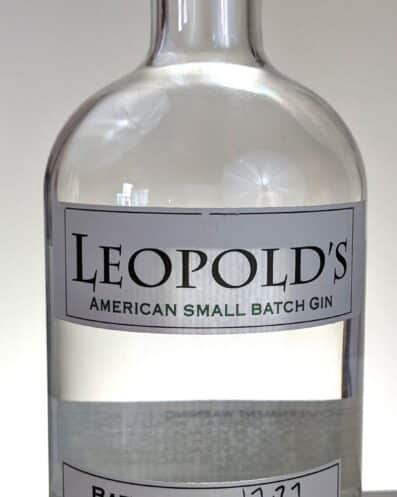Leopold’s gin— or more formally known as Leopold’s American Small Batch Gin— has been made since 2001. They might be one of the first gins on the market to individually hand number each bottle. And by the way, we’re reviewing Batch No. 17-27.
The Leopold Bros. distill each botanical in Leopold’s Gin separately before blending the distillates. Furthermore, as each batch is numbered and bottled individually, that means Leopold’s Gins each have a unique batch specific character. Only fifty cases from each run. Furthermore, Leopold’s gin has an eclectic base spirit. It’s distilled from wheat, potato and malted barley.
Tasting Notes
Traces of resinous juniper and pine terpenes on the nose, but vegetal notes and orange rind lend Leopold’s Gin a very contemporary impression.
There’s a gentle pine and terpenic aire on the nose. It’s slightly coniferous and resinous— suggesting juniper— but it really only adds some color. The dominant character is somewhere in this unusual blend of cucumber skin, celery stalk and orange rind. Leopold’s Gin suggests citrus and an herbal complexity at the same time. Being able to pull all three of these notes out of the nose without it ever feeling discordant is quite an accomplishment.
Leopold’s Gin is heavier on the palate than it’s 40% ABV might suggest. A hint of pine (not juniper) comes early. Then vegetable broth and a spiced citrus entrance to a long— and quite warm— finish.
The heat and warmth on the palate is surprising. Usually I find other 80 proof gins to be a little wanting in terms of warmth, viscosity and botanical strength. But certainly not Leopold’s American Small Batch Gin.
A green note lasts throughout the palate. It reminds me a bit of the aroma of damp maple leaves after a summer rain. It even suggest a hint of petrichor.
Sweet citrus builds behind the initial sip. Reminiscent of grapefruit pith replete with a hint of bitterness, the vegetal notes round things out. Spice comes on towards the finish, albeit as a background note. Leopold’s Gin has a hint of spicy coriander, cardamom, and cassia. But let’s be clear. None of these things come out shouting. It’s really a complex background note that grounds the gin.
Cocktails
Although I find Leopold Bros. Gin makes for a somewhat unusual gin and tonic, I find something alluring in the muskiness. Angelica root notes seem to jump out a bit more than the spirit neat. The Martini is perhaps a more mainstream alternative— the profile of Leopold’s Gin makes it work in every variation from the Alaska to the Dirty— or very Dirty— and maybe even the elusive Gibson. I think any more herbal/vegetal take on the classic cocktail works superbly with this gin.
As for other mixing, Leopold’s Gin brings a perspective that I advise bartenders to take into account when mixing up drinks. While it’s good on its own merits, it can throw a light floral drink like the Arsenic and Old Lace a bit out of sync— or be overshadowed in an equal parts Negroni.
Overall
Leopold’s Gin embraces the variation from batch to batch. This batch has a captivating complexity that will certainly appeal to fans of contemporary style gins. Bartenders should be advised to treat Leopold’s Gin as its own thing and design cocktails around each batch’s unique presentation.
Fans of classic gin will find it a little light on juniper, but I think Leopold’s Gin is a “must try at least once.” It’s longevity and commitment to the craft makes it an elder statesman of the American contemporary gin movement. I mean, relative to the time scale of the gin renaissance Leopold’s Gin is to other American contemporary gins what Gordon’s Gin is to Two Birds Gin.
Recommended in its category.

